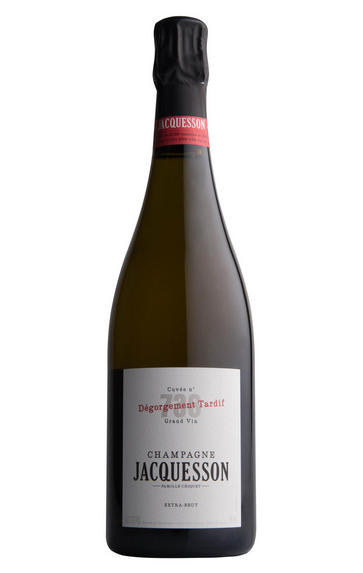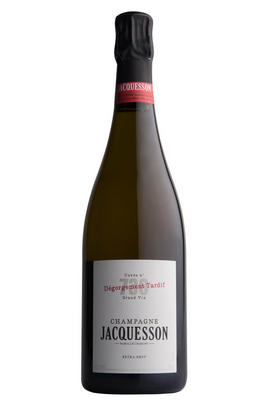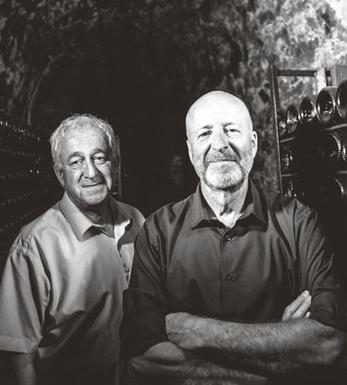
Champagne Jacquesson, Cuvée 736, Dégorgement Tardif, Extra Brut

Critics reviews
David Schildknecht - 30/11/2013
About this WINE

Jacquesson
Voted the third best of all Champagne Houses (after Bollinger and Krug) in 2005 La Revue Des Vins De France, Jacquesson has really come of age.
Based in the evocatively named town of Dizy, just to the north of Epernay, the House is run by the Chiquet brothers (cousins of our own Gaston Chiquet). The brothers are long-term advocates of the modish philosophy of zero dosage: this is put to the test in extremis with the equally modish move to release late disgorged cuvées: the juxtaposition of minimal sugar and extended lees ageing has produced these, some of the purest and most poised of all Champagnes, showing at their very best in magnum of course!
The house philosophy of releasing a clearly categorised Brut NV persists therefore, somewhat at odds with the historical precedent in the region which deliberately declines specifically to equate a batch with a certain vintage. Jacquesson's policy of so doing, albeit tangentially, is both a reflection of their adherence to the values of terroir and vintage diversity and a self-belief which over-rides any of the specific anxieties felt by the Champenois in relation to the conditions at a specific harvest.
These are very serious Champagnes with an emphasis on minerality and complexity of fruit. The wines have significant gravitas, are good food companions and age beautifully.

Brut Champagne
Brut denotes a dry style of Champagne (less than 15 grams per litre). Most Champagne is non-vintage, produced from a blend from different years. The non-vintage blend is always based predominately on wines made from the current harvest, enriched with aged wines (their proportion and age varies by brand) from earlier harvests, which impart an additional level of complexity to the end wine. Champagnes from a single vintage are labelled with the year reference and with the description Millésimé.
Non-vintage Champagnes can improve with short-term ageing (typically two to three years), while vintages can develop over much longer periods (five to 30 years). The most exquisite and often top-priced expression of a house’s style is referred to as Prestige Cuvée. Famous examples include Louis Roederer's Cristal, Moët & Chandon's Dom Pérignon, and Pol Roger's Cuvée Sir Winston Churchill.
Recommended Producers : Krug, Billecart Salmon, Pol Roger, Bollinger, Salon, Gosset, Pierre Péters, Ruinart

Champagne blend
Which grapes are included in the blend, and their proportion, is one of the key factors determining the style of most Champagnes. Three grapes are used - Pinot Noir, Chardonnay and Pinot Meunier.
26% of vineyards in Champagne are planted with Chardonnay and it performs best on the Côtes des Blancs and on the chalk slopes south of Epernay. It is relatively simple to grow, although it buds early and thus is susceptible to spring frosts. It produces lighter, fresher wines than those from Burgundy and gives finesse, fruit and elegance to the final blend. It is the sole grape in Blancs de Blancs, which are some of the richest long-lived Champagnes produced.
Pinot Noir accounts for nearly 40% of the plantings in Champagne and lies at the heart of most blends - it gives Champagne its body, structure, strength and grip. It is planted across Champagne and particularly so in the southern Aube district.
The final component is Pinot Meunier and this constitutes nearly 35% of the plantings. Its durability and resistance to spring frosts make the Marne Valley, a notorious frost pocket, its natural home. It ripens well in poor years and produces a soft, fruity style of wine that is ideal for blending with the more assertive flavours of Pinot Noir. Producers allege that Pinot Meunier lacks ageing potential, but this does not deter Krug from including around 15% of it in their final blends.


Buying options
Add to wishlist
Description
Based on vintage 2008 with 2007 and 2006 (totaling a third) in supporting roles, and 53% Chardonnay; 29% Pinot; 18% Meunier, the Jacquesson NV Extra Brut Cuvee 736 delivers a captivating performance in which prominent acidity, bone-dryness and underlying firmness that in lesser hands or from lesser material would come off as spare and austere, here instead blossom into an irresistibly mouthwatering wealth of scents of flavors. Lemon, grapefruit and white peach tinged with their pits and with pungent yeastiness are further allied with hickory nut bittersweetness, freshly milled cornmeal, mint, chalk, and brine both on the pungent nose and vibrant, gripping palate. Expansive yet productively tense and consummately refreshing, this finishes with cheek-pinching, salivary gland-milking intensity. It should prove rewarding to follow over at least the next 3-5 years, as well as from any subsequent disgorgements.
David Schildknecht - 30/11/2013
wine at a glance
Delivery and quality guarantee